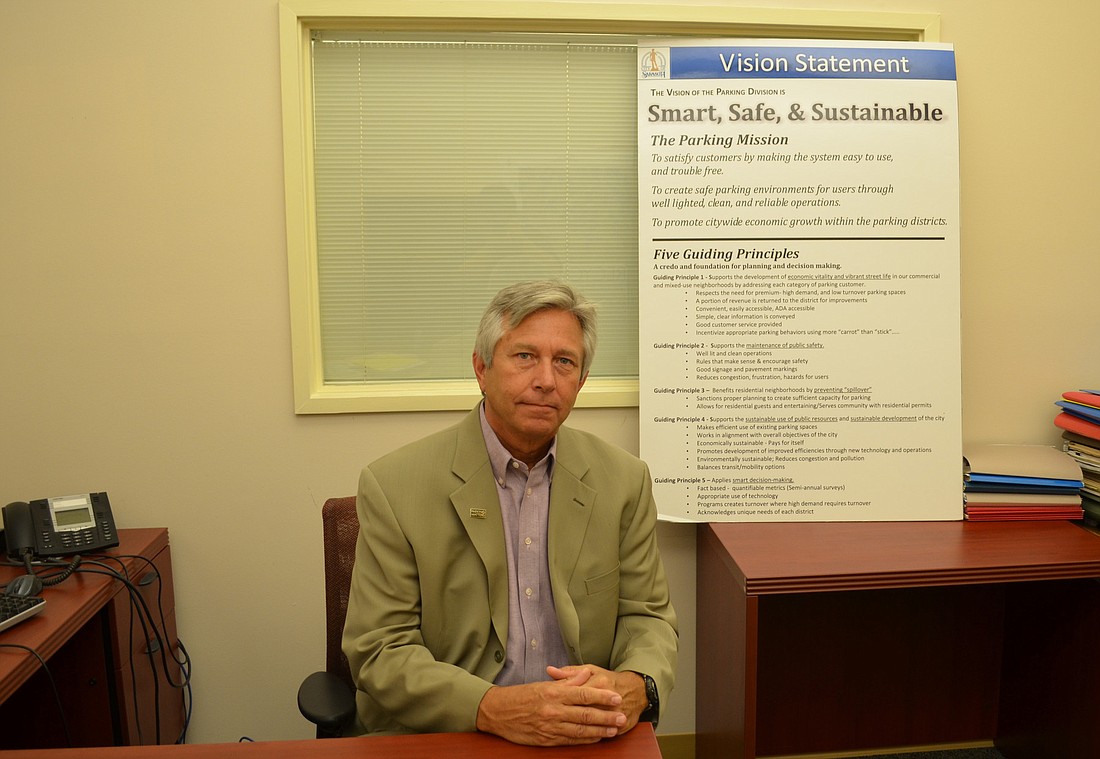- April 23, 2024
-
-
Loading

Loading

Members of the city’s Parking Advisory Committee are not eager to talk about paid parking, because the thrust of their work is focused on much more than that. Still, as the group works on the development of a citywide parking management plan, it wants one thing to be clear: It wants to avoid the missteps of the past.
“We didn’t educate well,” city Parking Manager Mark Lyons said of the failed attempts to institute paid parking. “We weren’t in the community as strongly as we could have been during that implementation.”
“Whatever happened last time, it didn’t happen in an orderly fashion,” committee Vice Chairman Tom Delong said. “You had meters all over the city in places they shouldn’t have been.”
For Lyons, tasked with producing the comprehensive parking strategic plan, the Parking Advisory Committee is a tool to make sure previous errors don’t recur. Rather than bring in a consulting firm and hold a couple of charrettes to gain public input, the advisory board is taking an active role in offering input throughout the process.
The Parking Advisory Committee, which has been meeting since May 2012, currently consists of seven members. Residents from various areas of the city — such as downtown, St. Armands Circle and Southside Village — serve as a representative mix of the areas the strategic plan will cover. Active in the community, the members bring new information back to their districts and offer specific feedback at the next meeting.
“You can’t buy that,” Lyons said. “It’s a way to really cascade information, take it into the community and bring it back.”
Chris Gallagher, a downtown resident and chairman of the committee, said the work has been more intensive than he originally expected. After articulating a specific goal — creating “smart, safe and sustainable parking” — the group has honed in on how to tackle the strategic plan.
“It’s one thing to have exactly the right system, exactly the right equipment,” Gallagher said. “The second thing is: How do you roll it out?”
Money woes
Even for Lyons, that second question has been more difficult to answer. The Parking Advisory Committee has found little guidance when it comes to getting a parking management program started in a large community.
“Most communities start paid parking when they’re smaller,” Lyons said. “They don’t launch it at this size.”
Lyons is less shy about directly addressing paid parking. Despite its failures in Sarasota, he believes it could help the community. He knows that no paid-parking program is capable of garnering universal support, but if the city is better at communication and implementation, he thinks a program could stick.
At Tuesday’s Downtown Improvement District meeting, the board demonstrated that significant opposition exists to any form of paid parking. DID member Eileen Hampshire, also a member of the Parking Advisory Committee, broached the subject of paid parking. As a response, the other board members voted to recommend the city take no steps toward such a program until May 1, 2016.
The DID members feared paid parking would scare customers away, and said the lack of easily accessible parking is just a sign of downtown’s success.
“You realize that no parking available downtown is a good thing,” DID member Mark Kauffman said.
Lyons said the goal would be more than just funding parking management — although, with a $500,000 annual deficit in the city’s parking fund, that would be one benefit. Beyond that, Lyons said, paid parking would discourage constant circulation as people search for parking places, providing a higher level of service for customers while decreasing congestion.
“Given time, a paid-parking system will prove its worth,” Lyons said. “It integrates in a way that makes it easier to come downtown.”
Again, that proper implementation is the big question Lyons has to answer, and why those involved don’t want their work boiled down to “paid parking is coming back.” At the last Parking Advisory Committee meeting, the group discussed focusing on managing the most-used areas first. Rather than a widespread re-launch of meters, Lyons said the city should focus on showing residents that any program could function in the areas best suited for paid parking.
The group knows that some areas of the city aren’t a good fit for paid parking. Determining where it would and wouldn’t work is part of Lyons’ job as he works on writing the management plan, which he hopes to have ready for presentation to the City Commission within the next 90 days.
Lyons and the members of the Parking Advisory Committee know the stakes are high, and they’re determined to succeed where the city has failed before.
“Parking seems like such a base subject to talk about, but people really have strong opinions about it,” Gallagher said. “If done incorrectly, it could have so many unintended consequences.”
Guiding the Way
In developing a citywide parking management plan, the city’s Parking Advisory Committee is using a set of five guiding principles as parameters:
Supporting the development of economic vitality and vibrant street life in our commercial and mixed-use neighborhoods by addressing each category of parking customer.
Supporting the maintenance of public safety.
Benefiting residential neighborhoods by preventing “spillover.”
Supporting the sustainable use of public resources and sustainable development of the city.
Applying smart decision-making.
Contact David Conway at [email protected]